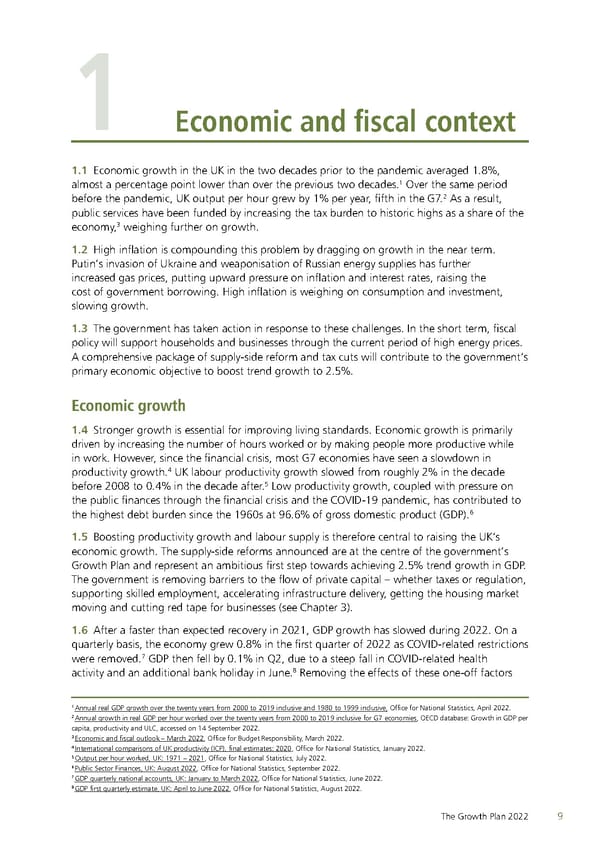1 Economic and fiscal context 1.1 Economic growth in the UK in the two decades prior to the pandemic averaged 1.8%, 1 almost a percentage point lower than over the previous two decades. Over the same period 2 before the pandemic, UK output per hour grew by 1% per year, fifth in the G7. As a result, public services have been funded by increasing the tax burden to historic highs as a share of the 3 economy, weighing further on growth. 1.2 High inflation is compounding this problem by dragging on growth in the near term. Putin’s invasion of Ukraine and weaponisation of Russian energy supplies has further increased gas prices, putting upward pressure on inflation and interest rates, raising the cost of government borrowing. High inflation is weighing on consumption and investment, slowing growth. 1.3 The government has taken action in response to these challenges. In the short term, fiscal policy will support households and businesses through the current period of high energy prices. A comprehensive package of supply-side reform and tax cuts will contribute to the government’s primary economic objective to boost trend growth to 2.5%. Economic growth 1.4 Stronger growth is essential for improving living standards. Economic growth is primarily driven by increasing the number of hours worked or by making people more productive while in work. However, since the financial crisis, most G7 economies have seen a slowdown in 4 productivity growth. UK labour productivity growth slowed from roughly 2% in the decade 5 before 2008 to 0.4% in the decade after. Low productivity growth, coupled with pressure on the public finances through the financial crisis and the COVID-19 pandemic, has contributed to 6 the highest debt burden since the 1960s at 96.6% of gross domestic product (GDP). 1.5 Boosting productivity growth and labour supply is therefore central to raising the UK’s economic growth. The supply-side reforms announced are at the centre of the government’s Growth Plan and represent an ambitious first step towards achieving 2.5% trend growth in GDP. The government is removing barriers to the flow of private capital – whether taxes or regulation, supporting skilled employment, accelerating infrastructure delivery, getting the housing market moving and cutting red tape for businesses (see Chapter 3). 1.6 After a faster than expected recovery in 2021, GDP growth has slowed during 2022. On a quarterly basis, the economy grew 0.8% in the first quarter of 2022 as COVID-related restrictions 7 were removed. GDP then fell by 0.1% in Q2, due to a steep fall in COVID-related health 8 activity and an additional bank holiday in June. Removing the effects of these one-off factors 1 Annual real GDP growth over the twenty years from 2000 to 2019 inclusive and 1980 to 1999 inclusive, Office for National Statistics, April 2022. 2 Annual growth in real GDP per hour worked over the twenty years from 2000 to 2019 inclusive for G7 economies, OECD database: Growth in GDP per capita, productivity and ULC, accessed on 14 September 2022. 3 Economic and fiscal outlook – March 2022, Office for Budget Responsibility, March 2022. 4 International comparisons of UK productivity (ICP), final estimates: 2020, Office for National Statistics, January 2022. 5 Output per hour worked, UK: 1971 – 2021, Office for National Statistics, July 2022. 6 Public Sector Finances, UK: August 2022, Office for National Statistics, September 2022. 7 GDP quarterly national accounts, UK: January to March 2022, Office for National Statistics, June 2022. 8 GDP first quarterly estimate, UK: April to June 2022, Office for National Statistics, August 2022. The Growth Plan 2022 9
 The Growth Plan 2022 Page 9 Page 11
The Growth Plan 2022 Page 9 Page 11